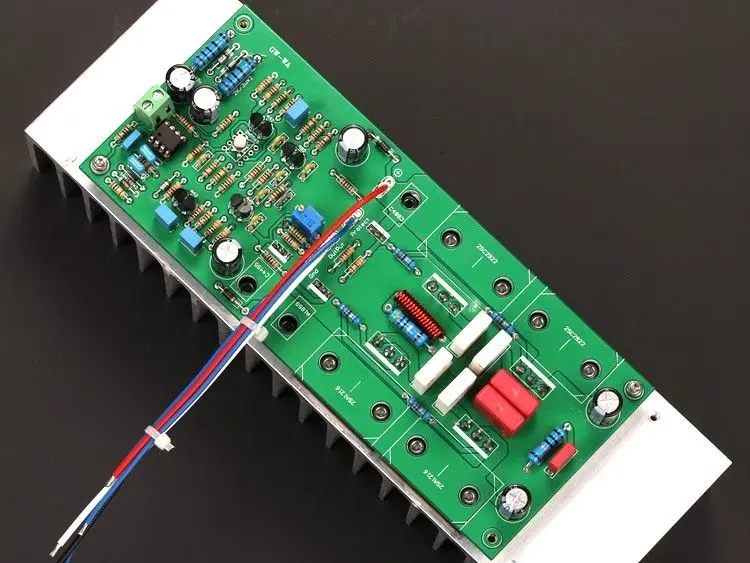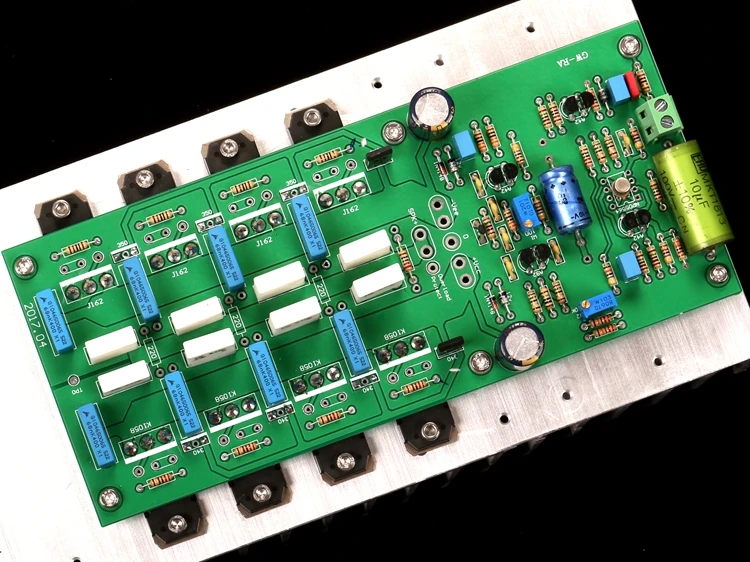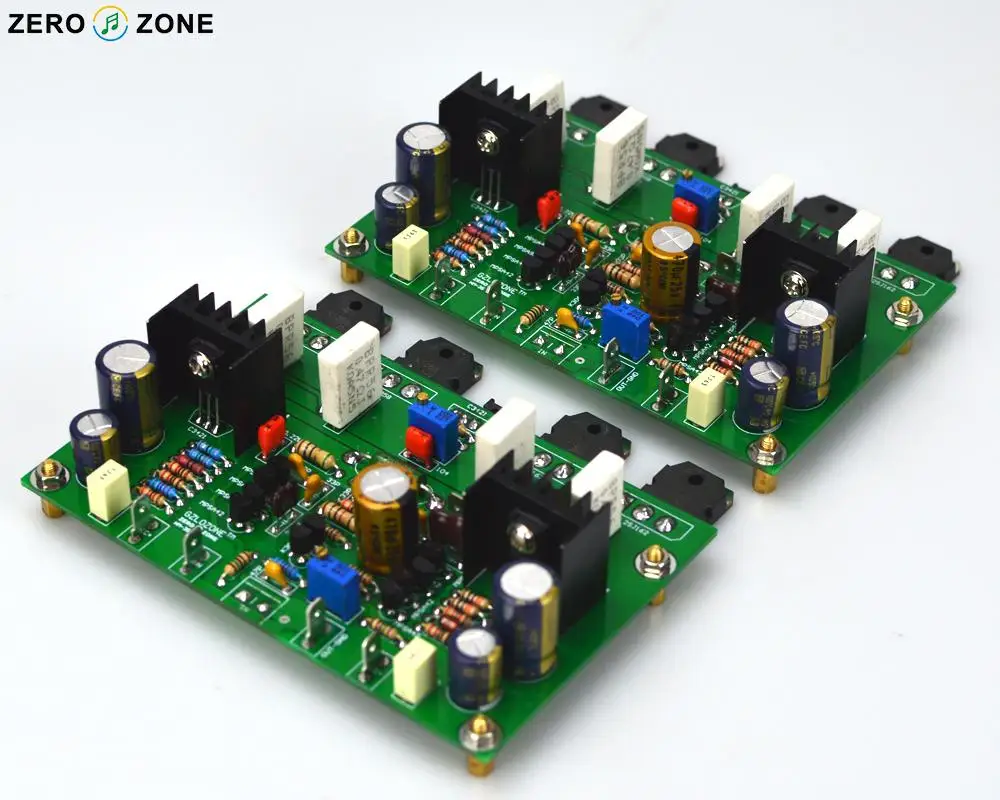Dear knowledgeable folks of DiyAudio, I want to build a Goldmund clone amp, and come across these following boards. Which would you choose and why? Does anybody know on what Goldmund amps these boards are based? Any experiences with these boards and tips on the build are very welcome too.
Extra boards and extra info will be added in follow up posts.
Board 1: 200W Mono Power Amp Board based on Goldmund Line + PSU Board L11-30, 2SC2922/A1216
As far as I can tell this mono channel board comes with a powersupply board with speaker protection and rectification and 4x 10.000uF 63v Rubicon capacitors. The voltage rating on the caps seems too low to me to make this into a powerfull 200watt amp (I think it needs like 70v DC to be a 200watt amp, please correct me when I am wrong).
Any experiences or thoughts about this board and the psu board?






Extra boards and extra info will be added in follow up posts.
Board 1: 200W Mono Power Amp Board based on Goldmund Line + PSU Board L11-30, 2SC2922/A1216
As far as I can tell this mono channel board comes with a powersupply board with speaker protection and rectification and 4x 10.000uF 63v Rubicon capacitors. The voltage rating on the caps seems too low to me to make this into a powerfull 200watt amp (I think it needs like 70v DC to be a 200watt amp, please correct me when I am wrong).
Any experiences or thoughts about this board and the psu board?






Board 2: Goldmund 29 200W 1 one channel ON high power tube MJL4281A MJL4302A power am
Info about board 2:
text from the seller:
- The line and parameters refer to the classic original GOLDMUND29 post-stage;
- Line characteristics: increase the DC adjustment line, the midpoint is within 1mV;
- Core material: the input stage transistor uses gold-plated pedal FET 2N3958;
- It is recommended to use more than 300w transformer per channel, AC35V---AC45V power supply. When powered by AC45V, 200W output power can be obtained at 8 ohms.
- About the radiator: Plate size: 248 * 83mm, finished board after the triode is installed: 248 * 112mm. Size of 8mm thick soaking plate: 251*116mm. The board has a large quiescent current and at least 2kG heat sink per channel.
- This board uses ON high power tube MJL4281A MJL4302A

Info about board 2:
text from the seller:
- The line and parameters refer to the classic original GOLDMUND29 post-stage;
- Line characteristics: increase the DC adjustment line, the midpoint is within 1mV;
- Core material: the input stage transistor uses gold-plated pedal FET 2N3958;
- It is recommended to use more than 300w transformer per channel, AC35V---AC45V power supply. When powered by AC45V, 200W output power can be obtained at 8 ohms.
- About the radiator: Plate size: 248 * 83mm, finished board after the triode is installed: 248 * 112mm. Size of 8mm thick soaking plate: 251*116mm. The board has a large quiescent current and at least 2kG heat sink per channel.
- This board uses ON high power tube MJL4281A MJL4302A

Hi
No idea which Goldmund amplifier this “clone” comes from...
I thought that Goldmund amplifiers used lateral mosfet as output (at least in the past) instead of Sanken bjt...
There seems to be 2 output RL filters, one on the main amplifier board and one on the power supply dc protection board...
I suggest that you read this thread on the Goldmund Telos if this is the clone model you are looking for:
Goldmund Wiki and build 2017
Personally I have built a clone based on jimsaudio (eBay seller) but pcb only. The pcb is fine except for the mounting of output which I have replaced with dual die mosfet for ease of assembly.
You should state 200W rms into what impedance (8, 4 , 3 ohms). Cap voltage rating is based on DC voltage used.
Fab
No idea which Goldmund amplifier this “clone” comes from...
I thought that Goldmund amplifiers used lateral mosfet as output (at least in the past) instead of Sanken bjt...
There seems to be 2 output RL filters, one on the main amplifier board and one on the power supply dc protection board...
I suggest that you read this thread on the Goldmund Telos if this is the clone model you are looking for:
Goldmund Wiki and build 2017
Personally I have built a clone based on jimsaudio (eBay seller) but pcb only. The pcb is fine except for the mounting of output which I have replaced with dual die mosfet for ease of assembly.
You should state 200W rms into what impedance (8, 4 , 3 ohms). Cap voltage rating is based on DC voltage used.
Fab
Last edited:
They seem to have missed that; nothing like substituting laterals for the what are likely fake sanken bjt.
The ones I have been using are these, they run at 44v. They are biased pretty good which helps a lot.
One pair Assembled HM3S High Bias Class AB Amplifier base GOLDMUND GM29 120W *2 | eBay
Typically when one mentions “boards”, it will mean a bare circuit board destined for hours of assembly and trouble shooting. It seems you are looking at assembled boards if I’m guessing correctly.
The ones I have been using are these, they run at 44v. They are biased pretty good which helps a lot.
One pair Assembled HM3S High Bias Class AB Amplifier base GOLDMUND GM29 120W *2 | eBay
Typically when one mentions “boards”, it will mean a bare circuit board destined for hours of assembly and trouble shooting. It seems you are looking at assembled boards if I’m guessing correctly.
Last edited:
Board 3: Goldmund 29 mono amplifier board
text from the seller:
- The board line parameters reference classic original GOLDMUND29 line
- Line characteristics: increase the DC adjustment line, the midpoint is within 1mV;
- Core material: the input stage transistor uses gold-plated pedal FET 2N3958;
- High-power tube: The last stage adopts 4 pairs of new precision matching Japanese position tube K1058/J162 in parallel;
- Quiescent current: 30mA per pair of tubes (statically adjustable)
- Power supply voltage: the original machine adopts DC±70v; the board is at DC±70v, the noise, midpoint and distortion are perfect;
In fact, DC±40---±70v is very good, I recommend ±55v (AC40V);
- Output power: 150w/8 ohms 300w/4 ohms;
- Plate size: 193*83mm plus power tube width is 112mm
- Each large tube has a decoupling capacitor in parallel:


text from the seller:
- The board line parameters reference classic original GOLDMUND29 line
- Line characteristics: increase the DC adjustment line, the midpoint is within 1mV;
- Core material: the input stage transistor uses gold-plated pedal FET 2N3958;
- High-power tube: The last stage adopts 4 pairs of new precision matching Japanese position tube K1058/J162 in parallel;
- Quiescent current: 30mA per pair of tubes (statically adjustable)
- Power supply voltage: the original machine adopts DC±70v; the board is at DC±70v, the noise, midpoint and distortion are perfect;
In fact, DC±40---±70v is very good, I recommend ±55v (AC40V);
- Output power: 150w/8 ohms 300w/4 ohms;
- Plate size: 193*83mm plus power tube width is 112mm
- Each large tube has a decoupling capacitor in parallel:


Board 4: Goldmund 29 HM3S
These are boards I read some good things about on this forum (thanks @phase!). All other boards so far are assembled boards, but these HM3S are also available as kits. And thats nice cos things like caps, resistors and transistors (for exicons) can be upgraded more easily. What do you guys think?
text from the seller:
- One pair HM3S High Bias Class AB Amplifier Kit base on GOLDMUND GM29
- Each PCB Size: 120*75*1.6MM (1OZ copper, FR4 grade A PCB material)
- Working voltage:+/-DC45V-55V (each channel transformer power recommend above 200VA)
- Output Power :120W+120W (Class AB)
- This amp also can be adjust as 30W +30W Class A amp.
- 23 times magnification
- Nichicon feedback capacitor, Panasonic retreat capacitor, the power tubes are using Original new Hitachi 2SK1058 2SJ162





These are boards I read some good things about on this forum (thanks @phase!). All other boards so far are assembled boards, but these HM3S are also available as kits. And thats nice cos things like caps, resistors and transistors (for exicons) can be upgraded more easily. What do you guys think?
text from the seller:
- One pair HM3S High Bias Class AB Amplifier Kit base on GOLDMUND GM29
- Each PCB Size: 120*75*1.6MM (1OZ copper, FR4 grade A PCB material)
- Working voltage:+/-DC45V-55V (each channel transformer power recommend above 200VA)
- Output Power :120W+120W (Class AB)
- This amp also can be adjust as 30W +30W Class A amp.
- 23 times magnification
- Nichicon feedback capacitor, Panasonic retreat capacitor, the power tubes are using Original new Hitachi 2SK1058 2SJ162





@phase
Indeed am looking at assembled boards and kits not just pcb's. I dont yet have the knowledge to source all the right components and do troubleshooting or design when buying bare pcb's.
I read you had reliability problems with the HM3S boards, do you still recommend these boards? did you find a way to get them reliable?
Indeed am looking at assembled boards and kits not just pcb's. I dont yet have the knowledge to source all the right components and do troubleshooting or design when buying bare pcb's.
I read you had reliability problems with the HM3S boards, do you still recommend these boards? did you find a way to get them reliable?
text from the seller:
- The board line parameters reference classic original GOLDMUND29 line
- Line characteristics: increase the DC adjustment line, the midpoint is within 1mV;
- Core material: the input stage transistor uses gold-plated pedal FET 2N3958;
- High-power tube: The last stage adopts 4 pairs of new precision matching Japanese position tube K1058/J162 in parallel;
- Quiescent current: 30mA per pair of tubes (statically adjustable)
- Power supply voltage: the original machine adopts DC±70v; the board is at DC±70v, the noise, midpoint and distortion are perfect;
In fact, DC±40---±70v is very good, I recommend ±55v (AC40V);
- Output power: 150w/8 ohms 300w/4 ohms;
- Plate size: 193*83mm plus power tube width is 112mm
- Each large tube has a decoupling capacitor in parallel:
We can recognize the bad translation talking about tubes...
The board does not match the schematics. The schematics shows individual driver for each output but the board shows one higher power driver for all output mosfet. This is not that important but is different from schematics...
The schematics does not show the potentiometers for adjustment but there seems to be 2 pots on the board ( DC offset and output bias.?).
Output bias of 30ma output is not enough to get the best of the lateral mosfet...
This one has at least lateral mosfet compared to other boards.
Your objective is not clear. Do you want the most genuine clown of a particular Golmund amp or you want something different as per your other boards #1 and #2 shown having Bjts as output?
Fab
Last edited:
@fab
Good to know it was just a random schematic that the seller added.
The goal is to build a good sounding poweramp with enough power to drive many different speakers.
It should be reliable, simple and affordable. Either kits or assembled boards of classic poweramps. Goldmund poweramps are supposed to sound great, there are plenty of assembled Goldmund boards available, so am looking for feedback/experience on which to choose. The goal is not to build an exact replica of a Goldmund amp.
Good to know it was just a random schematic that the seller added.
The goal is to build a good sounding poweramp with enough power to drive many different speakers.
It should be reliable, simple and affordable. Either kits or assembled boards of classic poweramps. Goldmund poweramps are supposed to sound great, there are plenty of assembled Goldmund boards available, so am looking for feedback/experience on which to choose. The goal is not to build an exact replica of a Goldmund amp.
The issues I’ve had are mostly such that they tend to be revealed with regular use over the course of a year or so. I now leave my amp on all the time and it has helped.
These are high slewing, high bandwidth amps with no input isolation, and the require decent cables, great care with what gets fed into them.
The ones delivered to me have had the bias set just about right for an optimal setup. This arrangement requires a decent heat sink or fans.
The power supply I wound up with is a pair of 32v 300va transformers, keeping both channels isolated except for a ground wire between the rca terminals. Previous attempts at using a single transformer created a hum that would not go away. Am also using separate speaker protection/delay boards as well.
I was made aware of these boards by another member here and they’re an overall huge improvement over the equipment I had been working with before. Just be prepared to maybe buy another pair if one has an issue that you don’t care to mess with.
These are high slewing, high bandwidth amps with no input isolation, and the require decent cables, great care with what gets fed into them.
The ones delivered to me have had the bias set just about right for an optimal setup. This arrangement requires a decent heat sink or fans.
The power supply I wound up with is a pair of 32v 300va transformers, keeping both channels isolated except for a ground wire between the rca terminals. Previous attempts at using a single transformer created a hum that would not go away. Am also using separate speaker protection/delay boards as well.
I was made aware of these boards by another member here and they’re an overall huge improvement over the equipment I had been working with before. Just be prepared to maybe buy another pair if one has an issue that you don’t care to mess with.
@phase
Will try the ferrites, have some laying around that should fit. And will go for 2 separate 32v toroid transformers like you.
Do you use a soft start module or thermistors on the primaries?
Whats the approximate size and weight of your heatsinks? Any problems with heat on your amp?
Will try the ferrites, have some laying around that should fit. And will go for 2 separate 32v toroid transformers like you.
Do you use a soft start module or thermistors on the primaries?
Whats the approximate size and weight of your heatsinks? Any problems with heat on your amp?
Hi again, I used individual (mono) speaker protection modules for each channel, powered by a common 12v transformer. The heat sinks are such that they should support the thermal energy of around 40 watts per channel, or devise a scheme using fans.
I used a large washer on top of each output, and torqued them to around 8 in/lb, using a beam torque wrench.
I used a large washer on top of each output, and torqued them to around 8 in/lb, using a beam torque wrench.
Hi Just wondering in respect of the above if you proceeded with any of these boards and if so how it worked out? I have an old MOSFET 200 x 2 watt RMS amp that I just rebuilt and am looking to build another one. It is a very simple design with 6 power FETs per side running on +- 70 volt rails but sounds awesome so I didn't want to move too far from that topology. However would prefer as you mentioned not to source all the components just fit pre assembled boards.
- Home
- Amplifiers
- Solid State
- Goldmund clone boards, which would you choose and why?